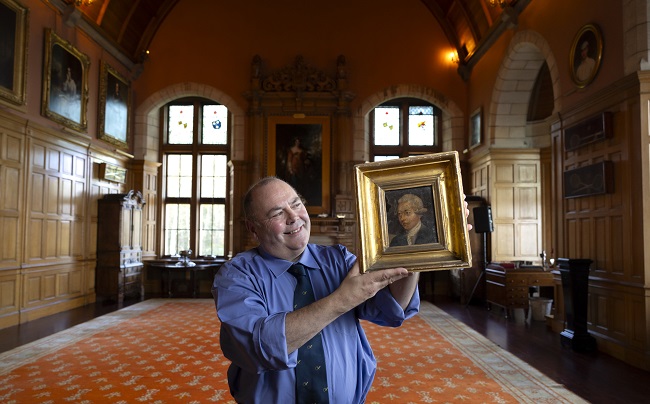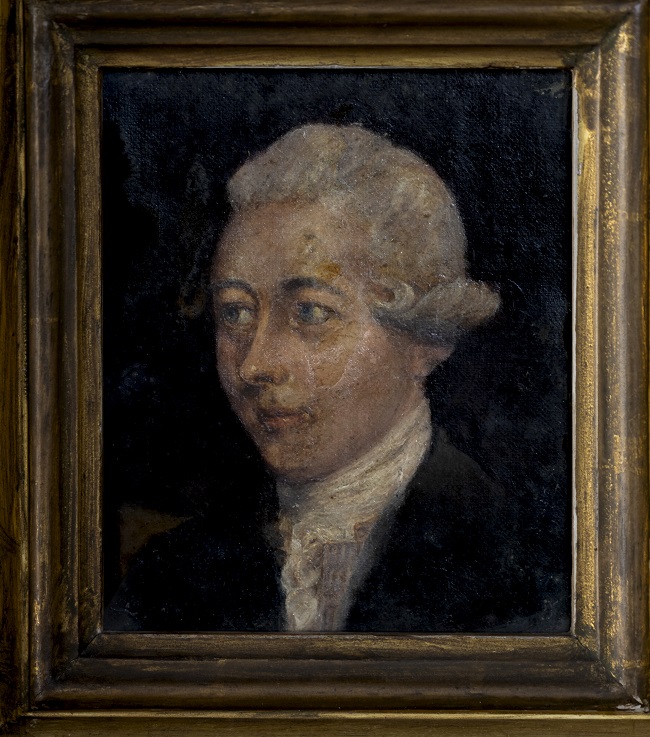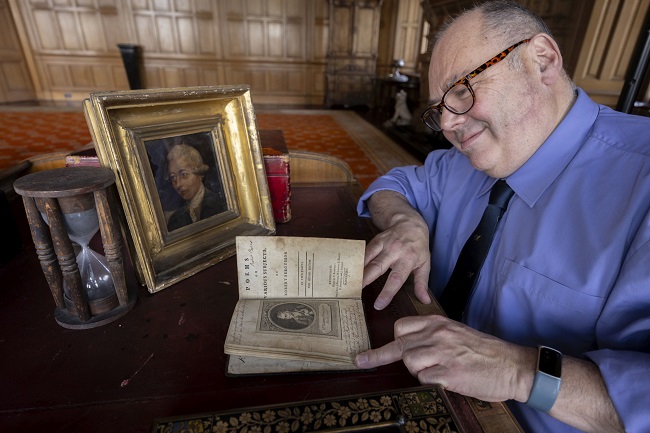Intriguing 18th century portrait sparks Robert Fergusson speculation
Published: 28 November 2024
An intriguing 18th-century portrait discovered at a Scottish Castle has ignited excitement among literary scholars, coinciding with the 250th anniversary of the death of celebrated Scottish poet Robert Fergusson.

An intriguing 18th-century portrait discovered at a Scottish Castle has ignited excitement among literary scholars, coinciding with the 250th anniversary of the death of celebrated Scottish poet Robert Fergusson.
The painting at Barnbougle Castle, near Edinburgh, is part of the prestigious collection of the 5th Earl of Rosebery, a former Prime Minister and noted Scottish antiquarian, and has been meticulously investigated by Professor Gerard Carruthers.
Professor Carruthers, a leading Scottish Literature scholar, says previously only three known likenesses of Fergusson from his lifetime existed – a crude sketch in the Cape Club minute-book for 1773, a portrait by Alexander Runciman and a painting by an unknown artist, said to have once been in the possession of the artist Henry Raeburn.
Professor Carruthers’ research suggests the newly highlighted portrait may be a previously unknown lifetime likeness of Fergusson, who died tragically young at just 24 years old in 1774.
Professor Carruthers, who is the University of Glasgow’s Francis Hutcheson Chair of Scottish Literature, said: “This discovery could be one of the most significant Fergusson finds in decades. The portrait’s provenance and artistic features suggest it may be the very artwork mentioned in Fergusson’s own poem ‘Codicile to Rob. Fergusson’s Last Will,’ where he references a portrait intended for his publisher Walter Ruddiman.”
Fergusson, a prodigiously talented writer in Scots, left an indelible mark on Scottish literature despite his very short life. His work and untimely death profoundly inspired Robert Burns, who referred to Fergusson as his “elder brother in misfortune ... [&] in the muse”.
It is hoped that the new portrait may represent a significant fourth addition to the historical depictions of Fergusson.

The portrait, which has an inscription on the back which reads ‘Portrait of Robert Ferugson, and where it came from has yielded three intriguing possibilities. The most compelling evidence, says Professor Carruthers, points toward James Cummyng, a fellow member of Fergusson’s Cape Club and a portrait painter who served as Herald Painter and Lyon Clerk Depute.
Professor Carruthers said: “While examining a copy of Fergusson’s works that belonged to Robert Burns, a portrait was also kindly presented for examination by Lady Jane Kaplan at Barnbougle Castle. I realised when I saw it, we might be looking at a lost artwork of immense significance. This may well match a fabled ‘lost portrait’ of Fergusson or be one hitherto entirely unknown.
“Whatever the case, we have here a late 18th century oil portrait of Fergusson, very possibly painted during his lifetime, and for which he may well have sat. The heraldic illustrations in the frame and surrounding the painting align perfectly with Cummyng’s official role in regulating Scottish coats of arms.”
Other theories include the portrait being the work of Andrew Fyfe, a skilled draughtsman and prize-winning painter who had connections to Fergusson’s artistic circles, or potentially a likeness of Fergusson’s sister who was known to bear a strong resemblance to the poet.by an unknown painter.
The portrait has also sparked interest among art historians. James Holloway, the former Director of the Scottish National Portrait Gallery, has confirmed the painting's late 18th-century origins, though he was unable to attribute it to a known artist.
Mr Holloway added: “It is a wonderful discovery and a great rarity. I congratulate Professor Carruthers.”

The newly discovered 18th century portrait is part of the collection of former 19th Century Prime Minister, Archibald Primrose, 5th Earl of Rosebery, 1st Earl of Midlothian, who was a keen collector, historian and writer. The Primrose family have given access to University of Glasgow scholars from the Centre for Robert Burns Studies to increase their knowledge and understanding of great Scottish literary figures like Burns and now Fergusson. This relationship has already led to two discoveries – the first was detailed lists of materials for the construction of Burns’ Ellisland Farm, outside Dumfries in 2023 and then in January 2024, the discovery of a cancelled Burns manuscript of his Ye Jacobites by Name poem.
Lady Jane Kaplan along with her brother Harry, the 8th Earl of Rosebery, the great-grandchildren of the 5th Earl, have been instrumental in supporting the Centre for Robert Burns Studies research into their family’s collection.
Lord Rosebery said: “It’s deeply moving to see our family’s stewardship of these literary treasures bearing such remarkable fruit. Following the discoveries of the Ellisland Farm drawings and Burns’ Ye Jacobites by Name manuscript, this latest Fergusson find further demonstrates the extraordinary depth of our great-grandfather’s collecting vision. Now this Fergusson portrait and working with the University of Glasgow's Centre for Robert Burns Studies show that after more than 200 years, Scotland’s poetic heritage can still surprise and delight us with new insights.”
The discovery comes as the University of Glasgow leads commemorations marking the 250th anniversary of Fergusson’s death through the Leverhulme Trust-funded project “The Works of Robert Fergusson: Reconstructing Textual and Cultural Legacies”. This initiative aims to publish a new edition of Fergusson’s complete works and explore his enduring influence on Scottish literature.
The portrait discovered at Barnbougle will be unveiled to an audience at Irvine Burns Club on Friday 29 November 2024. Robert Burns moved to Irvine in 1781 and while staying there he found a book of poetry by Fergusson in a local bookshop, which fired his creativity particularly in Scots.
Bill Nolan, Hon Secretary, The Irvine Burns Club, which celebrates its 200th anniversary in 2026, said: “Willie Templeton, a local Irvine bookseller, introduced Robert Burns to the verses in Scots of Robert Fergusson, as a possible medium for his own poems. By his own admission, Burns chose Fergusson as his muse and while there is no doubt that Burns could - and did - write in English, it was his ability to write and publish in Scots that has set Burns apart from other 18th Century Scottish versifiers. Thanks to Irvine's influence, and especially that of Willie Templeton in introducing him to Fergusson’s poetry, Robert Burns’s works remains as alive and relevant today as they did more than 200 years ago.”
Robert Fergusson
Robert Fergusson (5 September 1750 – 17 October 1774) was an Edinburgh poet whose short life belied his significant impact. His textual, medical, linguistic and cultural legacies were substantial, to the extent that Scotland’s national bard Robert Burns regarded Fergusson as his 'elder brother in the muse'.
'The Works of Robert Fergusson: Reconstructing Textual and Cultural Legacies'
The University of Glasgow's project 'The Works of Robert Fergusson: Reconstructing Textual and Cultural Legacies' is funded by the Leverhulme Trust. This project has two aims: to produce a new scholarly edition of Fergusson’s works for the 21st century reader; and to commemorate the poet’s legacies through academic and collaborative events with external partners throughout 2024 (the 250th anniversary of his death) and 2025. The project will provide a comprehensive edition, but also asks: how do we understand Fergusson’s legacies in the twenty-first century?
Learn more: https://robert-fergusson.glasgow.ac.uk/
The Centre for Robert Burns Studies
The Centre for Robert Burns Studies (CRBS) is the world’s leading centre for the study of Scotland’s national poet Robert Burns (1759-96), his contexts and associated literatures.
Establishing itself as a cross-disciplinary area of research excellence which has attracted major financial and intellectual investment, CRBS has brought together the largest concentration of Burns experts in the world and their work has impact on a global scale.
In February 2024, CRBS was awarded a Queen's Anniversary Prize for Higher Education for the work of the world’s leading centre for the study of Scotland’s national poet. The Queen's Anniversary Prizes celebrate excellence, innovation and public benefit in work carried out by UK colleges and universities. The Prizes are the highest national Honour awarded in UK further and higher education and are granted every two years.
First published: 28 November 2024

